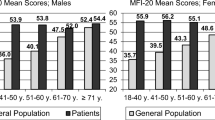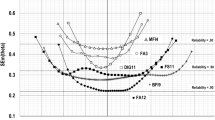Abstract
Objective
Fatigue is one of the most prevalent and significant symptoms experienced by breast cancer patients. This study aimed to investigate potential population heterogeneity in fatigue symptoms of the patients using the innovative non-normal mixture modeling.
Methods
A sample of 197 breast cancer patients completed the brief fatigue inventory and other measures on cancer symptoms. Non-normal factor mixture models were analyzed and compared using the normal, t, skew-normal, and skew-t distributions. Selection of the number of latent classes was based on the Bayesian information criterion (BIC). The identified classes were validated by comparing their demographic profiles, clinical characteristics, and cancer symptoms using a stepwise distal outcome approach.
Results
The observed fatigue items displayed slight skewness but evident negative kurtosis. Factor mixture models using the normal distribution pointed to a 3-class solution. The t distribution mixture models showed the lowest BIC for the 2-class model. The restored class (52.5 %) exhibited moderate severity (item mean = 2.8–3.2) and low interference (item mean = 1.1–1.9). The exhausted class (47.5 %) displayed high levels of fatigue severity and interference (item mean = 5.8–6.6). Compared to the restored class, the exhausted class reported significantly higher perceived stress, anxiety, depression, pain, sleep disturbance, and lower quality of life.
Conclusions
The non-normal factor mixture models suggest two distinct subgroups of patients on their fatigue symptoms. The presence of the exhausted class with exacerbated symptoms calls for a proactive assessment of the symptoms and development of tailored interventions for this subgroup.



Similar content being viewed by others
References
Curt, G. A., Breitbart, W., Cella, D., Groopman, J. E., Horning, S. J., Itri, L. M., et al. (2000). Impact of cancer-related fatigue on the lives of patients: New findings from the Fatigue Coalition. The Oncologist, 5(5), 353–360.
Meeske, K., Smith, A., Alfano, C., McGregor, B., McTiernan, A., Baumgartner, K., et al. (2007). Fatigue in breast cancer survivors two to five years post diagnosis: A HEAL Study report. Quality of Life Research, 16(6), 947–960. doi:10.1007/s11136-007-9215-3.
Horneber, M., Fischer, I., Dimeo, F., Rüffer, J. U., & Weis, J. (2012). Cancer-related fatigue: Epidemiology, pathogenesis, diagnosis, and treatment. Deutsches Arzteblatt International, 109(9), 161–171. (quiz 172).
Skerman, H., Yates, P., & Battistutta, D. (2012). Cancer-related symptom clusters for symptom management in outpatients after commencing adjuvant chemotherapy, at 6 months, and 12 months. Supportive Care in Cancer, 20(1), 95–105. doi:10.1007/s00520-010-1070-z.
Lockefeer, J. P. M., & De Vries, J. (2013). What is the relationship between trait anxiety and depressive symptoms, fatigue, and low sleep quality following breast cancer surgery? Psycho-Oncology, 22(5), 1127–1133. doi:10.1002/pon.3115.
Mosher, C. E., & DuHamel, K. N. (2012). An examination of distress, sleep, and fatigue in metastatic breast cancer patients. Psycho-Oncology, 21(1), 100–107. doi:10.1002/pon.1873.
MacCallum, R. C., Zhang, S. B., Preacher, K. J., & Rucker, D. D. (2002). On the practice of dichotomization of quantitative variables. Psychological Methods, 7(1), 19–40. doi:10.1037/1082-989x.7.1.19.
Dirksen, S. R., Belyea, M. J., & Epstein, D. R. (2009). Fatigue-based subgroups of breast cancer survivors with insomnia. Cancer Nursing, 32(5), 404–411.
Vermunt, J. K., & Magidson, J. (2002). Latent class cluster analysis. In J. A. Hagenaars & A. L. McCutcheon (Eds.), Applied latent class analysis (pp. 89–106). Cambridge, MA: Cambridge University Press.
Lubke, G. H., & Muthén, B. (2005). Investigating population heterogeneity with factor mixture models. Psychological Methods, 10(1), 21–39. doi:10.1037/1082-989X.10.1.21.
Bauer, D. J., & Curran, P. J. (2003). Distributional assumptions of growth mixture models: Implications for overextraction of latent trajectory classes. Psychological Methods, 8(3), 338–363. doi:10.1037/1082-989x.8.3.338.
Bauer, D. J., & Curran, P. J. (2003). Overextraction of latent trajectory classes: Much ado about nothing? Reply to Rindskopf (2003), Muthen (2003), and Cudeck and Henly (2003). Psychological Methods, 8(3), 384–393. doi:10.1037/1082-989x.8.3.384.
Asparouhov, T., & Muthen, B. (2014). Structural equation models and mixture models with continuous non-normal skewed distributions. Mplus Web Note, 19, 1–49.
Lee, S., & McLachlan, G. J. (2014). Finite mixtures of multivariate skew t-distributions: Some recent and new results. Statistics and Computing, 24(2), 181–202. doi:10.1007/s11222-012-9362-4.
Wang, X. S., Hao, X. S., Wang, Y., Guo, H., Jiang, Y. Q., Mendoza, T. R., et al. (2004). Validation study of the Chinese version of the brief fatigue inventory (BFI-C). Journal of Pain and Symptom Management, 27(4), 322–332. doi:10.1016/j.jpainsymman.2003.09.008.
Lin, C. C., Chang, A. P., Chen, M. L., Cleeland, C. S., Mendoza, T. R., & Wang, X. S. (2006). Validation of the Taiwanese version of the Brief Fatigue Inventory. Journal of Pain and Symptom Management, 32(1), 52–59. doi:10.1016/j.jpainsymman.2005.12.019.
Leung, D. Y. P., Lam, T. H., & Chan, S. S. C. (2010). Three versions of Perceived Stress Scale: Validation in a sample of Chinese cardiac patients who smoke. BMC Public Health, 10, 513. doi:10.1186/1471-2458-10-513.
Fong, T. C. T., & Ho, R. T. H. (2013). Factor analyses of the Hospital Anxiety and Depression Scale: A Bayesian structural equation modeling approach. Quality of Life Research, 22(10), 2857–2863. doi:10.1007/s11136-013-0429-2.
Wang, X. S., Mendoza, T. R., Gao, S.-Z., & Cleeland, C. S. (1996). The Chinese version of the Brief Pain Inventory (BPI-C): Its development and use in a study of cancer pain. Pain, 67(2–3), 407–416. doi:10.1016/0304-3959(96)03147-8.
Tsai, P. S., Wang, S. Y., Wang, M. Y., Su, C. T., Yang, T. T., Huang, C. J., et al. (2005). Psychometric evaluation of the Chinese version of the Pittsburgh Sleep Quality Index (CPSQI) in primary insomnia and control subjects. Quality of Life Research, 14(8), 1943–1952. doi:10.1007/s11136-005-4346-x.
Wan, C., Zhang, D., Yang, Z., Tu, X., Tang, W., Feng, C., et al. (2007). Validation of the simplified Chinese version of the FACT-B for measuring quality of life for patients with breast cancer. Breast Cancer Research and Treatment, 106(3), 413–418. doi:10.1007/s10549-007-9511-1.
Kline, R. B. (2011). Principles and practice of structural equation modeling (3rd ed.). New York: Guilford Press.
Muthén, L. K., & Muthén, B. (1998-2012). Mplus user’s guide (7th ed.). Los Angeles, CA: Muthen & Muthen.
Little, R. J. A., & Rubin, D. B. (1987). Statistical analysis with missing data. New York: Wiley.
Azzalini, A. (1985). A class of distributions which includes the normal ones. Scandinavian Journal of Statistics, 12(2), 171–178.
Lin, T. I., Lee, J. C., & Yen, S. Y. (2007). Finite mixture modelling using the skew normal distribution. Statistica Sinica, 17(3), 909–927.
Azzalini, A., & DallaValle, A. (1996). The multivariate skew-normal distribution. Biometrika, 83(4), 715–726. doi:10.1093/biomet/83.4.715.
Lin, T.-I. (2010). Robust mixture modeling using multivariate skew t distributions. Statistics and Computing, 20(3), 343–356. doi:10.1007/s11222-009-9128-9.
Nylund, K. L., Asparoutiov, T., & Muthén, B. O. (2007). Deciding on the number of classes in latent class analysis and growth mixture modeling: A Monte Carlo simulation study. Structural Equation Modeling-a Multidisciplinary Journal, 14(4), 535–569.
Fraley, C., & Raftery, A. E. (1998). How many clusters? Which clustering method? Answers via model-based cluster analysis. Computer Journal, 41(8), 578–588. doi:10.1093/comjnl/41.8.578.
Celeux, G., & Soromenho, G. (1996). An entropy criterion for assessing the number of clusters in a mixture model. Journal of Classification, 13(2), 195–212. doi:10.1007/bf01246098.
Muthén, B. (2003). Statistical and substantive checking in growth mixture modeling: Comment on Bauer and Curran (2003). Psychological Methods, 8(3), 369–377. doi:10.1037/1082-989x.8.3.369.
Lanza, S. T., Tan, X., & Bray, B. C. (2013). Latent class analysis with distal outcomes: A flexible model-based approach. Structural Equation Modeling: A Multidisciplinary Journal, 20(1), 1–26. doi:10.1080/10705511.2013.742377.
Piper, B. E., & Cella, D. (2010). Cancer-related fatigue: Definitions and clinical subtypes. Journal of the National Comprehensive Cancer Network, 8(8), 958–966.
Molassiotis, A., Wengström, Y., & Kearney, N. (2010). Symptom cluster patterns during the first year after diagnosis with cancer. Journal of Pain and Symptom Management, 39(5), 847–858. doi:10.1016/j.jpainsymman.2009.09.012.
Liu, L. Q., Fiorentino, L., Natarajan, L., Parker, B. A., Mills, P. J., Sadler, G. R., et al. (2009). Pre-treatment symptom cluster in breast cancer patients is associated with worse sleep, fatigue and depression during chemotherapy. Psycho-Oncology, 18(2), 187–194. doi:10.1002/pon.1412.
Sunderland, M., Carragher, N., Wong, N., & Andrews, G. (2013). Factor mixture analysis of DSM-IV symptoms of major depression in a treatment seeking clinical population. Comprehensive Psychiatry,. doi:10.1016/j.comppsych.2012.12.011.
Acknowledgments
We would like to thank Hong Kong Cancer Fund, Queen Mary Hospital, Pamela Youde Nethersole Eastern Hospital, and Dr. M.Y. Luk for their help in patient recruitment and all the patients who participated in the study. The paper would not have been possible without the expert opinions and generous help offered by Dr. Bengt Muthén and the non-normal mixture modeling recently implemented in Mplus version 7.2.
Conflict of interest
The authors report no conflict of interests. The first author (R.T.H.H.) was supported by the Research Grants Council General Research Fund (HKU745110H) for this study.
Author information
Authors and Affiliations
Corresponding author
Rights and permissions
About this article
Cite this article
Ho, R.T.H., Fong, T.C.T. & Cheung, I.K.M. Cancer-related fatigue in breast cancer patients: factor mixture models with continuous non-normal distributions. Qual Life Res 23, 2909–2916 (2014). https://doi.org/10.1007/s11136-014-0731-7
Accepted:
Published:
Issue Date:
DOI: https://doi.org/10.1007/s11136-014-0731-7




